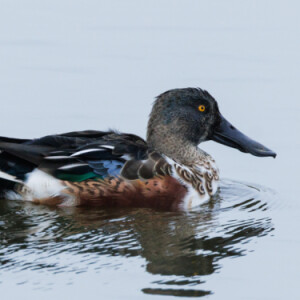Moulty
After faffing around all morning, trying and failing to decide what to do, I finally got a grip and took myself off to Slimbridge. I had low expectations of this trip, which usually pays, and in the event the weather and the birds were both kind, and I had such a good time that I overran my pumpkin hour and only just made it home in time for dinner. An unexpected bonus was bumping into Happy_Janwen and Incredibish - a blipencounter, if not exactly a blipmeet.
I logged thirty eight species during my visit, which wasn't bad given that it was after 1pm when I arrived. One of them was a currently much-twitched juvenile Barred Warbler, of which the best I can say is that it was bigger than I thought it would be, and very... grey. I hadn't expected to see it, as it's famously shy (and therefore presumably pretty fed up with its current celebrity status), but I got my sighting by happening to be in the Estuary Tower at just the right moment, with half a dozen other people who all knew what they were looking for. What felt like several hours of minutely detailed directions - very much in the style of The Golden Shot - finally got my binoculars onto the bullseye: a cryptic lump of beak and feathers in a hedgerow about fifty metres away. And not before time: two seconds later the bird departed. Ten seconds after that so did I, in search of something more photogenic.
Despite the more photogenic things including some nice Redshanks and Blackwits, and incoming migrant Pochards, Tufted Ducks and Pintails, my favourite shots of the day have turned out to be this pair of photos of a male Shoveler. I especially like the way he's turned himself into piece of modernist architecture in the main image (The Sydney Opera House," said R as soon as he saw it), but the extra is more generally descriptive.
One of the interesting things about ducks is that during their annual moult they lose all their flight feathers at once, leaving them flightless for about a month until the new ones grow in. This obviously makes them vulnerable to predation, so the males also moult their bright breeding feathers and grow what's called "eclipse" plumage, which is similar to that of the more cryptic females. This gives them some protection until their flight feathers regrow, after which they undergo a second, partial moult to get rid of the dowdy eclipse and reappear in their breeding finery. This male is part way through that second moult: the barred feathers on his breast and flanks are giving way to blocks of white and chestnut, and the grey of his head is beginning to turn green. His new flight feathers are in place, and here he's nicely showing his distinctive pale blue forewing feathers, which are separated from the green speculum by a white margin.
A couple of bonus fun facts about the Shoveler. Quarter of a millennium after it was named Anas clypeata by Linnaeus, the genus Anas was split into four, and the Shoveler was renamed Spatula clypeata. Both parts of its new name refer to its unusual bill: 'spatula' means spoon (or, indeed, spatula), and 'clypeata' means shield-bearing. So it's the duck that carries a spoon-shaped shield. As currently described, the genus Spatula contains ten species - four types of shoveler, the Garganey, and five species of teal. Though not our own native Teal, which continues to be Anas crecca. Taxonomists, eh? I bet they're fun at parties.


Comments
Sign in or get an account to comment.


